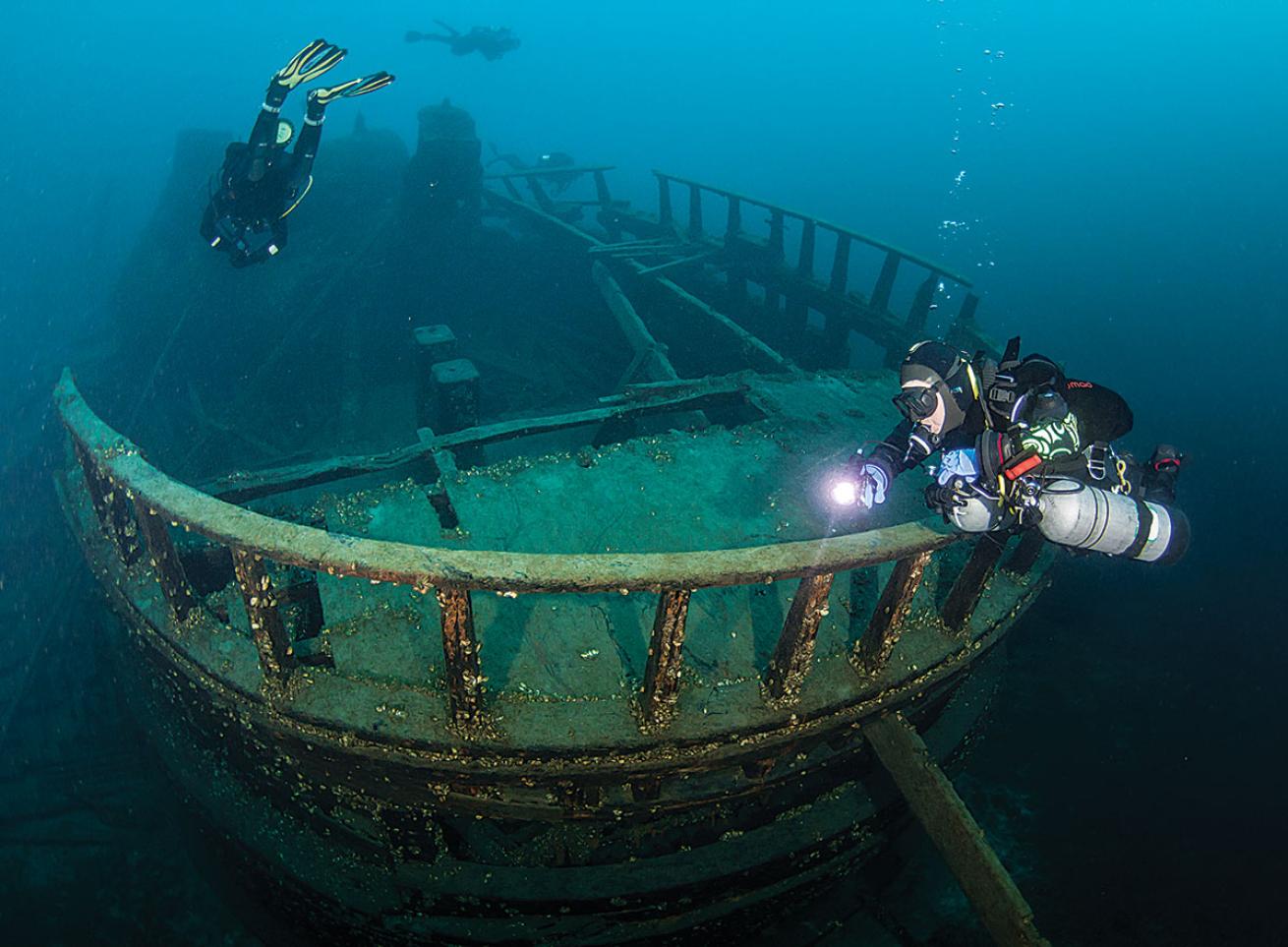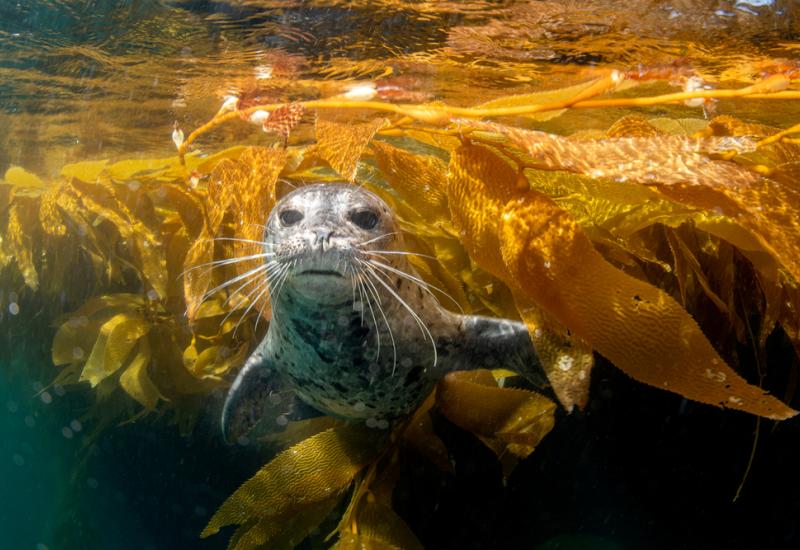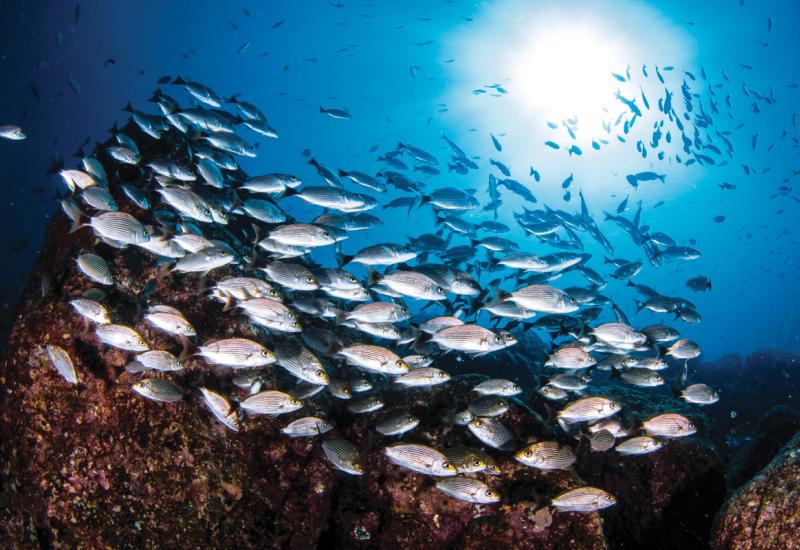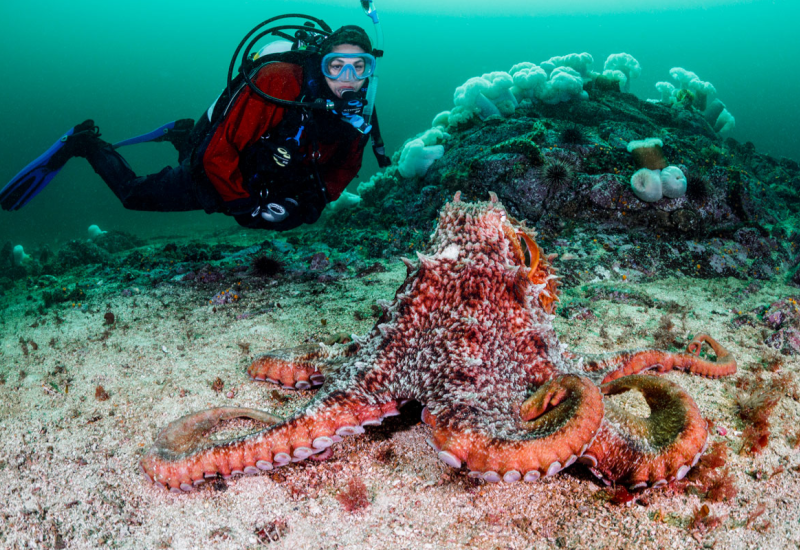Wreck Diving in Tobermory, Canada - Fathom Five National Marine Park

The Forest City Wreck
The Forest City met its fate after ramming Bear's Rump Island; the most interesting parts lie between 100 and 150 feet.
Andy Morrison
The thrill of diving the shipwrecks of Tobermory came long before I made a giant stride into the frigid Canadian waters of Lake Huron. It was born of the countless stories told by Great Lakes divers who shared accounts of the magnificent shipwrecks and spectacular scenery. It also came from numerous accounts rating Tobermory among the best the Great Lakes has to offer.
I needed to see for myself. My much-anticipated first dive was on the Arabia, a striking three-masted wooden barque that sank in October 1884 in heavy seas, forcing the crew to abandon ship. Sought out because of its beauty and interest to divers, only the experienced should attempt the Arabia because its depth — about 120 feet — and cold waters can create difficult conditions.
I descended the line to the bow, where my dive buddy and I spent most of our air, despite knowing an intact captain’s wheel — a definite must-see — stood at the stern. The Arabia is an excellent example of how the chilly, fresh water of the Great Lakes preserves maritime history: Rigging hung from the bowsprit that pierced the water, and chains spilled of the windlass onto the deck. Deadeyes stared up at me as I hovered over the railings while taking my time exploring the mostly intact hull. I couldn’t ask for more.
Another of Tobermory’s more-challenging dives is the Forest City. A three-masted wooden schooner later converted into a steamer, the Forest City sank in June 1904 after running full-steam into an island in a dense fog.
The ship now rests almost perpendicular to the island, with the bow at 60 feet, gradually descending to about 150 feet at the stern. Stick to your dive plan on this wreck because the ease of the descent and the sights found among the ship’s broken decking can easily lead you beyond your planned depth. Thanks to 50-plus-foot visibility, I was able to observe the Forest City’s intact stern railing — its signature feature — while staying at my planned maximum depth of 120 feet.
Tobermory is located at the northern tip of the South Bruce Peninsula, a slice of land that juts out into Lake Huron, forming the western border of the Georgian Bay. Peppered with islands, the waters around Tobermory attract all sorts of water enthusiasts.
Divers come because of the abundance and variety of shipwrecks, ranging from novice depths to technical. Sharp underwater inclines, which loom into islands above the water’s surface, meant captains cruising along in deep water might unexpectedly find themselves colliding with a shallow shoal. The result: several downed ships, many of which can be reached on a single tank of air.
Fathom Five National Marine Park protects many of these treasures. Canada’s first national marine park, Fathom Five was designated in 1987 and encompasses 45 square miles consisting of 20 islands and 22 shipwrecks. Parks Canada charges divers a nominal fee before they can enjoy all Tobermory has to offer.
OUTSIDE THE PARK
Not everything is inside Fathom Five, however, including one of the area’s best — the City of Cleveland. The boat ride out to the wreck is nearly two hours, but it is worth the trip.
A 255-foot steamer that sank in September 1901 after being forced of-course by devastating waves, the City of Cleveland has been called the most impressive shallow dive in the Great Lakes. While many of Tobermory’s shipwrecks are better suited for the experienced diver, the City of Cleveland is a playground for all experience levels. The only drawback is the long boat ride it takes to reach it, but it’s worth the lengthy round-trip commute.
The steamer’s bow sits at about 10 feet below the water’s surface, with its deepest point at about 30 feet. The shallow dive meant more bottom time to check out the steam engine with its massive boilers, the rudder, and the main attraction — an immense propeller resting upright in sand.
Just when you think you’ve seen all of Tobermory’s amazing offerings, your dive boat will drop anchor at one more. For us, it was the 182-foot Niagara II, also outside the park boundaries. The Niagara II was purpose-sunk in 1999 by the Tobermory Maritime Association to alleviate pressure on the area’s older wrecks. The 182-foot sand- sucker sits at about 100 feet, ripe for exploration. Locals had a bit of fun prepping this wreck for divers, adding items like a piano, which is fairly smashed up now.
We tied in at the bow and descended into the cold, clear water. We spent a lot of time at the pilothouse, where a ship’s wheel can be found, thanks to a replica placed by association members. We then slipped along the portside deck to the stern, penetrating the hull and slipping over rails along the way.
After four days spending as much time on and under the water as possible, it became clear — Tobermory definitely lives up to its reputation. We’ll return soon to dive some other don’t-miss sites: the 175-foot former barge James C. King and the 130-foot former schooner San Jacinto, as well as Dunk’s Point, North Otter Wall and the Caves, which is at the base of a limestone cliff and features two underwater entrances that lead to a picturesque grotto in 20 feet of water.
More Epic Diving in North America
Explore California's Sonoma Coast

Andy MorrisonThe Forest City Wreck
The Forest City met its fate after ramming Bear's Rump Island; the most interesting parts lie between 100 and 150 feet.
The thrill of diving the shipwrecks of Tobermory came long before I made a giant stride into the frigid Canadian waters of Lake Huron. It was born of the countless stories told by Great Lakes divers who shared accounts of the magnificent shipwrecks and spectacular scenery. It also came from numerous accounts rating Tobermory among the best the Great Lakes has to offer.
I needed to see for myself. My much-anticipated first dive was on the Arabia, a striking three-masted wooden barque that sank in October 1884 in heavy seas, forcing the crew to abandon ship. Sought out because of its beauty and interest to divers, only the experienced should attempt the Arabia because its depth — about 120 feet — and cold waters can create difficult conditions.
I descended the line to the bow, where my dive buddy and I spent most of our air, despite knowing an intact captain’s wheel — a definite must-see — stood at the stern. The Arabia is an excellent example of how the chilly, fresh water of the Great Lakes preserves maritime history: Rigging hung from the bowsprit that pierced the water, and chains spilled of the windlass onto the deck. Deadeyes stared up at me as I hovered over the railings while taking my time exploring the mostly intact hull. I couldn’t ask for more.
Another of Tobermory’s more-challenging dives is the Forest City. A three-masted wooden schooner later converted into a steamer, the Forest City sank in June 1904 after running full-steam into an island in a dense fog.
The ship now rests almost perpendicular to the island, with the bow at 60 feet, gradually descending to about 150 feet at the stern. Stick to your dive plan on this wreck because the ease of the descent and the sights found among the ship’s broken decking can easily lead you beyond your planned depth. Thanks to 50-plus-foot visibility, I was able to observe the Forest City’s intact stern railing — its signature feature — while staying at my planned maximum depth of 120 feet.
Tobermory is located at the northern tip of the South Bruce Peninsula, a slice of land that juts out into Lake Huron, forming the western border of the Georgian Bay. Peppered with islands, the waters around Tobermory attract all sorts of water enthusiasts.
Divers come because of the abundance and variety of shipwrecks, ranging from novice depths to technical. Sharp underwater inclines, which loom into islands above the water’s surface, meant captains cruising along in deep water might unexpectedly find themselves colliding with a shallow shoal. The result: several downed ships, many of which can be reached on a single tank of air.
Fathom Five National Marine Park protects many of these treasures. Canada’s first national marine park, Fathom Five was designated in 1987 and encompasses 45 square miles consisting of 20 islands and 22 shipwrecks. Parks Canada charges divers a nominal fee before they can enjoy all Tobermory has to offer.
OUTSIDE THE PARK
Not everything is inside Fathom Five, however, including one of the area’s best — the City of Cleveland. The boat ride out to the wreck is nearly two hours, but it is worth the trip.
A 255-foot steamer that sank in September 1901 after being forced of-course by devastating waves, the City of Cleveland has been called the most impressive shallow dive in the Great Lakes. While many of Tobermory’s shipwrecks are better suited for the experienced diver, the City of Cleveland is a playground for all experience levels. The only drawback is the long boat ride it takes to reach it, but it’s worth the lengthy round-trip commute.
The steamer’s bow sits at about 10 feet below the water’s surface, with its deepest point at about 30 feet. The shallow dive meant more bottom time to check out the steam engine with its massive boilers, the rudder, and the main attraction — an immense propeller resting upright in sand.
Just when you think you’ve seen all of Tobermory’s amazing offerings, your dive boat will drop anchor at one more. For us, it was the 182-foot Niagara II, also outside the park boundaries. The Niagara II was purpose-sunk in 1999 by the Tobermory Maritime Association to alleviate pressure on the area’s older wrecks. The 182-foot sand- sucker sits at about 100 feet, ripe for exploration. Locals had a bit of fun prepping this wreck for divers, adding items like a piano, which is fairly smashed up now.
We tied in at the bow and descended into the cold, clear water. We spent a lot of time at the pilothouse, where a ship’s wheel can be found, thanks to a replica placed by association members. We then slipped along the portside deck to the stern, penetrating the hull and slipping over rails along the way.
After four days spending as much time on and under the water as possible, it became clear — Tobermory definitely lives up to its reputation. We’ll return soon to dive some other don’t-miss sites: the 175-foot former barge James C. King and the 130-foot former schooner San Jacinto, as well as Dunk’s Point, North Otter Wall and the Caves, which is at the base of a limestone cliff and features two underwater entrances that lead to a picturesque grotto in 20 feet of water.
More Epic Diving in North America
Explore California's Sonoma Coast










